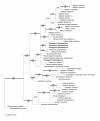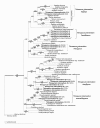On the genome constitution and evolution of intermediate wheatgrass (Thinopyrum intermedium: Poaceae, Triticeae)
- PMID: 21592357
- PMCID: PMC3123223
- DOI: 10.1186/1471-2148-11-127
On the genome constitution and evolution of intermediate wheatgrass (Thinopyrum intermedium: Poaceae, Triticeae)
Abstract
Background: The wheat tribe Triticeae (Poaceae) is a diverse group of grasses representing a textbook example of reticulate evolution. Apart from globally important grain crops, there are also wild grasses which are of great practical value. Allohexaploid intermediate wheatgrass, Thinopyrum intermedium (2n = 6x = 42), possesses many desirable agronomic traits that make it an invaluable source of genetic material useful in wheat improvement. Although the identification of its genomic components has been the object of considerable investigation, the complete genomic constitution and its potential variability are still being unravelled. To identify the genomic constitution of this allohexaploid, four accessions of intermediate wheatgrass from its native area were analysed by sequencing of chloroplast trnL-F and partial nuclear GBSSI, and genomic in situ hybridization.
Results: The results confirmed the allopolyploid origin of Thinopyrum intermedium and revealed new aspects in its genomic composition. Genomic heterogeneity suggests a more complex origin of the species than would be expected if it originated through allohexaploidy alone. While Pseudoroegneria is the most probable maternal parent of the accessions analysed, nuclear GBSSI sequences suggested the contribution of distinct lineages corresponding to the following present-day genera: Pseudoroegneria, Dasypyrum, Taeniatherum, Aegilops and Thinopyrum. Two subgenomes of the hexaploid have most probably been contributed by Pseudoroegneria and Dasypyrum, but the identity of the third subgenome remains unresolved satisfactorily. Possibly it is of hybridogenous origin, with contributions from Thinopyrum and Aegilops. Surprising diversity of GBSSI copies corresponding to a Dasypyrum-like progenitor indicates either multiple contributions from different sources close to Dasypyrum and maintenance of divergent copies or the presence of divergent paralogs, or a combination of both. Taeniatherum-like GBSSI copies are most probably pseudogenic, and the mode of their acquisition by Th. intermedium remains unclear.
Conclusions: Hybridization has played a key role in the evolution of the Triticeae. Transfer of genetic material via extensive interspecific hybridization and/or introgression could have enriched the species' gene pools significantly. We have shown that the genomic heterogeneity of intermediate wheatgrass is higher than has been previously assumed, which is of particular concern to wheat breeders, who frequently use it as a source of desirable traits in wheat improvement.
Figures



Similar articles
-
Contrasting patterns of evolution of 45S and 5S rDNA families uncover new aspects in the genome constitution of the agronomically important grass Thinopyrum intermedium (Triticeae).Mol Biol Evol. 2013 Sep;30(9):2065-86. doi: 10.1093/molbev/mst106. Epub 2013 Jun 4. Mol Biol Evol. 2013. PMID: 23741054
-
Gene capture from across the grass family in the allohexaploid Elymus repens (L.) Gould (Poaceae, Triticeae) as evidenced by ITS, GBSSI, and molecular cytogenetics.Mol Biol Evol. 2010 Jun;27(6):1370-90. doi: 10.1093/molbev/msq021. Epub 2010 Jan 27. Mol Biol Evol. 2010. PMID: 20106909
-
Reticulate evolution, introgression, and intertribal gene capture in an allohexaploid grass.Syst Biol. 2004 Feb;53(1):25-37. doi: 10.1080/10635150490424402. Syst Biol. 2004. PMID: 14965898
-
Detection of alien chromatin introgression from Thinopyrum into wheat using S genomic DNA as a probe--a landmark approach for Thinopyrum genome research.Cytogenet Genome Res. 2005;109(1-3):350-9. doi: 10.1159/000082419. Cytogenet Genome Res. 2005. PMID: 15753596 Review.
-
Use of wild relatives to improve salt tolerance in wheat.J Exp Bot. 2006;57(5):1059-78. doi: 10.1093/jxb/erj124. Epub 2006 Mar 2. J Exp Bot. 2006. PMID: 16513812 Review.
Cited by
-
Development of a wheat single gene FISH map for analyzing homoeologous relationship and chromosomal rearrangements within the Triticeae.Theor Appl Genet. 2014 Mar;127(3):715-30. doi: 10.1007/s00122-013-2253-z. Epub 2014 Jan 10. Theor Appl Genet. 2014. PMID: 24408375 Free PMC article.
-
Molecular cytogenetic (FISH) and genome analysis of diploid wheatgrasses and their phylogenetic relationship.PLoS One. 2017 Mar 9;12(3):e0173623. doi: 10.1371/journal.pone.0173623. eCollection 2017. PLoS One. 2017. PMID: 28278169 Free PMC article.
-
Safety of grain and flour from perennial intermediate wheatgrass (Thinopyrum intermedium) as a novel food pursuant to Regulation (EU) 2015/2283.EFSA J. 2025 Jun 10;23(6):e9467. doi: 10.2903/j.efsa.2025.9467. eCollection 2025 Jun. EFSA J. 2025. PMID: 40496252 Free PMC article.
-
Comparative Characterization of Pseudoroegneria libanotica and Pseudoroegneria tauri Based on Their Repeatome Peculiarities.Plants (Basel). 2023 Dec 15;12(24):4169. doi: 10.3390/plants12244169. Plants (Basel). 2023. PMID: 38140496 Free PMC article.
-
Chromosomal distribution of a new centromeric Ty3-gypsy retrotransposon sequence in Dasypyrum and related Triticeae species.J Genet. 2012;91(3):343-8. doi: 10.1007/s12041-012-0181-3. J Genet. 2012. PMID: 23271019 No abstract available.
References
-
- Vogel KP, Jensen KJ. Adaptation of perennial triticeae to the eastern Central Great Plains. J Range Manag. 2001;54:674–679. doi: 10.2307/4003670. - DOI
-
- Tsitsin NV. Novyi vid i novye raznovidnosti pshenitsy. (New species and varieties of wheats) Byul Gl Bot Sada AN SSSR. 1960;38:38–41.
-
- Tsvelev NN. Conspectus specierum tribus Triticeae Dum. familiae Poaceae in flora URSS. Nov Sist Vyssh Rast. 1973;10:19–59.
-
- Friebe B, Gill KS, Tuleen NA, Gill BS. Transfer of wheat streak mosaic virus resistance from Agropyron intermedium into wheat. Crop Sci. 1996;36:857–861. doi: 10.2135/cropsci1996.0011183X003600040006x. - DOI
Publication types
MeSH terms
Substances
LinkOut - more resources
Full Text Sources

